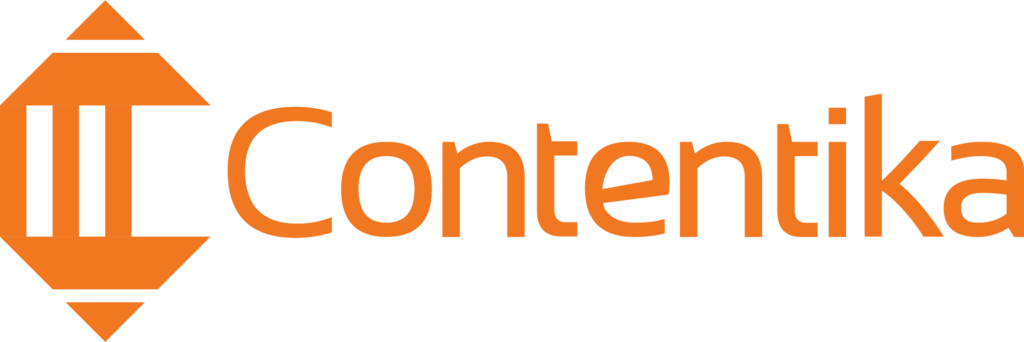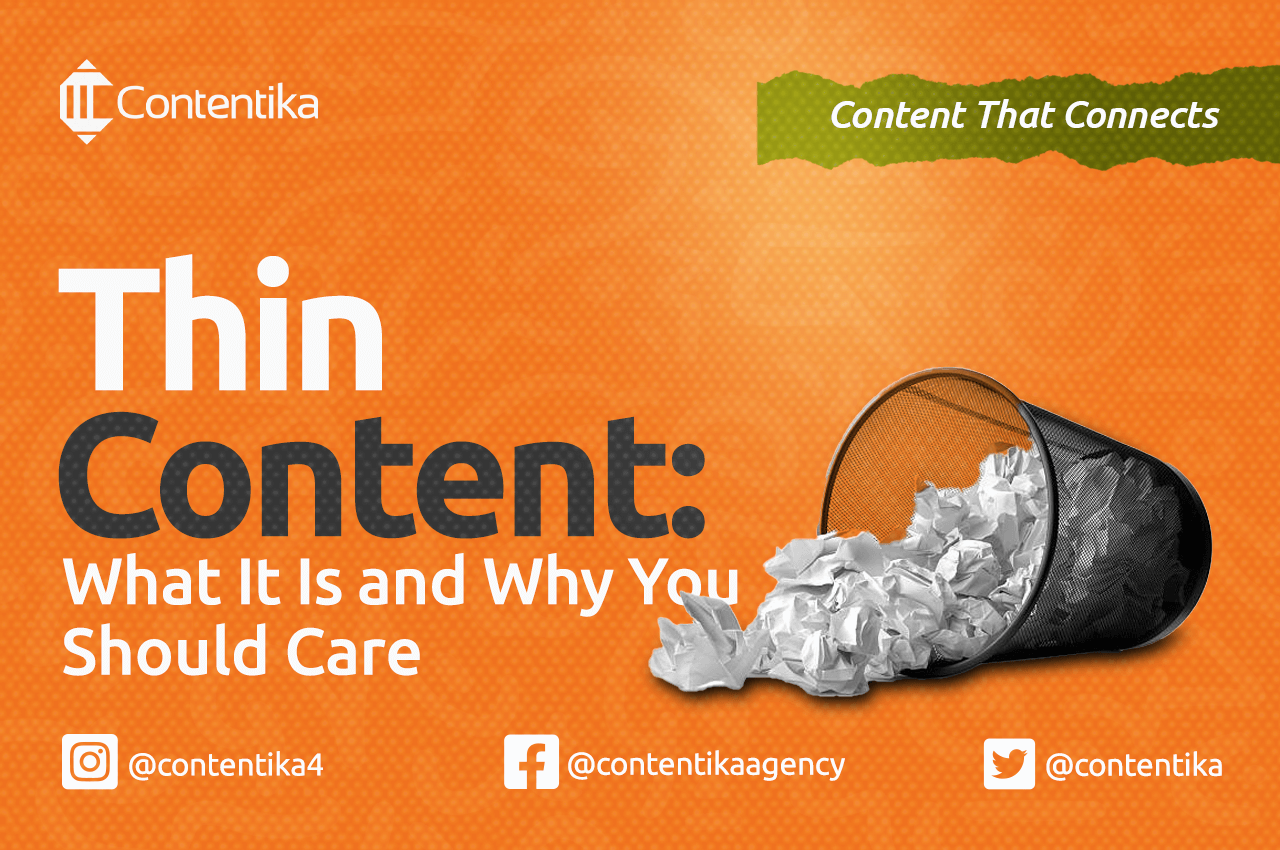
Marketing is the life and blood of any business. It is not just about selling a product or service; it is about building a loyal customer base that stays with the brand over time. To achieve this, marketing requires a deep understanding of the market, the pain points of the target audience, and how to structure the product or service to meet their needs.
Visual marketing holds significant sway over shaping an audience’s perception of a brand, despite the existence of various other forms of marketing. This is attributed to the way the human brain processes images.
Humans are visual beings, and the human brain processes visually content 60,000 times faster than text.
For a brand marketer or business owner, this means one thing. One sure means of engaging your ideal customers is by using visual storytelling in your marketing.
The Benefits of Visual Marketing Strategy
A visual marketing strategy is a method in which businesses use films, photographs, graphics, memes, and other types of imagery to sell their products or services as well as the brand as a whole. Brands may use photography to tell their narrative in a captivating way that engages customers and makes it possible for them to interact with the brand.
Brands use visual marketing to help them depict messages that would otherwise be too technical or uninteresting for the target audience to understand in text format.
A visual marketing strategy has a lot of benefits, but the main one is that it helps build audience engagement and, as a result, increases sales. Since this is the end goal of any form of marketing, visual marketing is a great call.
A Fast Way to Reach Out to The Audience
In any context, the human brain processes visual representations faster than their written counterparts. Because the brain finds pictures stimulating, it tends to respond better to them than it would to plain text.
The reason for this is that the brain processes visuals 60,000 times faster than it will process a body of text. A study reveals that if the human eyes saw an image for a short span of time, even as little as 13 milliseconds, the brain would recognize such image. On the other hand, for texts, the brain would need to process the words individually, and this takes longer time.
Since reading texts requires more mental energy, the brain is more likely to exert itself from comprehending them. This means that if a business makes content that is just text, its customers may not want to read it. There is a higher chance of getting through to customers if the message also has some visual display.
Audience Retain Visual Information Longer
You might be familiar with the expression “a picture speaks a thousand words.” To an extent, this can be said to be correct because pictures can be used to convey complex and multiple ideas that might not be effectively communicated in words or texts.
In marketing, however, a picture speaks more than a thousand words. This is because pictures are more deeply felt than words in the human mind. Unlike texts, visuals leave lasting impressions and are therefore hard to forget.
From this, it follows that when a brand tells its story visually, the information stays in people’s minds. This makes the brand easier to remember and helps them to connect your brand with a need they have.
And if there is anything marketers should know, it is that successful marketing is not achieved at the moment you portray your brand to the audience. No, true marketing is the effect that your brand has on the audience such that, when you are not there, they remember you.
Helps to Create an Emotional Connection
One essential quality of a visual marketing strategy is the power of storytelling. A brand can tell its story and convey its beliefs, opinions, and values through visuals. The point of telling stories is to find a kindred spirit, a conviction for friendship, similar interests or dislikes, and essentially to form an emotional connection. This is common in human relationships, and it is no different for a brand.
Storytelling shapes how customers feel about a brand, which is what makes them feel connected to the brand. Stories make a brand relatable to the average Joe.
At the point where potential customers feel like they can relate to you as a brand or share similar values, they will be more willing to trust you and build a relationship with you. This consequently builds brand loyalty.
A good example of a brand using visuals to connect with customers is Goodlife Fitness. This brand moved away from the images of well-chiseled men and incredibly well-shaped women that are the norm for gym brands.
Instead, Goodlife Fitness launched its #SexySmartStrong campaign. This marketing video featured people telling their stories and defining what “sexy,” “smart,” and “strong” meant to them.
In 2018, it was followed by the #ChangeYourStory campaign, which centered on members of the brand sharing the stories and motivation behind their transformations.
If anything, these stories of real people would no doubt redefine the customer experience and make them feel seen.
Creates a Better Chance of Generating Leads
The first step to building your consumer base as a brand is to attract prospects. It is this attraction, and not necessarily the quality of your product, that gets them through the door for the first time. This is lead generation, and every business needs it.
Lead generation is the interest you spark in a target audience for your product or service. The end goal of lead generation is to convert consumer interest into sales.
Now, what would get new people interested in a new brand or an existing one? Although word of mouth can be an effective marketing strategy for an established brand, it is considered a passive approach.
The one thing that would spark a potential customer’s interest in your brand is how you present it to them—basically, marketing. Visual marketing helps in this way because you can appeal to an audience with visually pleasing imagery and not just text.
Records show that when texts are paired with interesting and colorful visuals, there is a higher chance of attracting your target customers. Besides, when the audience comes across visualized data, it makes purchasing decisions easy.
Types of Visual Content
Infographics

The term “infographics” is the combination of two words, “information” and “graphics.” This is a graphic representation that combines the use of text and visual elements to form visual displays for sending brand messages or information.
Infographics are one of the most effective types of visual content, and this is largely due to their concise nature and how well they help with data visualization. Although most consumers base their purchase decisions on data, not everyone has the time or attention span to go through some lengthy research or report.
Infographics thus come in handy by summing up long walls of text or information into an easy-to-digest and interesting visual format. Even though it is a simplified form of information, the concept or quality is not watered down or compromised.
Another advantage of infographics is that it is easy for consumers to share, thereby increasing a brand’s reach. In fact, it was found that infographics are three times more shared and engaged than other forms of visual content. They are easily adaptable into blog posts, surveys and statistics results, product comparisons, etc.
Videos

Video is another way brands reach out to retail consumers, busy professionals, and other categories of customers who do not have the time to go through lengthy articles.
Videos are especially helpful if your brand sells products that show customers how to fix problems they are having. For example, if your business makes a detergent that gets rid of even the most stubborn stains, you can make a product video, an animation, or include customer testimonials.
Video content is one of the best ways to save time on marketing because it combines audio and video, which can turn long minutes of reading into minutes of entertainment.
Marketers can incorporate video content on the landing pages of brands’ websites or the “About Us” section.
Images

There is no denying the fact that the attention span of the average person is relatively short. Besides, with almost every brand producing digital content, customers can easily get bored. As such, you will need content that not only grabs customers’ attention but also sustains it.
Using images is one sure way to attract potential customers visually. As previously stated, an image is worth more than a thousand words. It tells stories and inspires actions. When it is used to split the texts in an article, it entices customers to read on.
Importantly, unlike plain words, images aid easy remembrance. After 3 days, people tend to remember about 10% of what they heard, but 65% of what they saw in pictures.
Meanwhile, for images to have any sort of impact, they must be genuine, authentic, and of real quality. This means that the use of stock images is not advisable.
Consumers need to be able to relate to your marketing. Images can be of customers, the product, or the result that is guaranteed when your services are used.
Asides from drawing consumers’ interest to your brand, images also help to put a face to your brand. This also helps to boost brand visibility.
Memes

Originally, memes were shared as a humorous form of entertainment. In today’s marketing scene, they have become an interesting form of visual content used by brands to grow audience engagement.
Before you set out to use memes as a brand, though, there are factors to consider. First, what demographic is your target audience? Another question to answer is what your brand’s tone is.
If your brand is more focused on older folks, say within the age range of 65 to 75, you probably have no business introducing memes to your visual marketing. If, on the other hand, a lot of your customers are young adults or millennials, you should know that using memes in your marketing is likely to get people more interested in your brand.
For a millennial-centric brand, using memes makes you appear cool and make inside jokes with your consumers. Memes relax the intensity of your brand message by giving it a humorous feel.
Presentations

Traditionally, the use of presentations was restricted to the four walls of a boardroom. However, with technology constantly evolving, presentations can now be used by businesses as a means of communication with their consumers.
To some extent, a presentation is an advanced form of an infographic. Like infographics, it also uses a blend of text and images to portray information.
Presentation, on the other hand, is more general and is mostly used for topics that would be too long for infographics. Presentations can be shared with the audience through sites like SlideShare.
When creating a presentation, it is crucial to remain consistent in little details like colors, fonts, borders, etc. This is to aid the flow of information. Having details messed up can make the presentation seem untidy, and this might tire out the brain.
Screenshots

Understandably, this might appear as the least important in this list of content forms, but it should not be viewed this way. Screenshots are, in fact, a crucial element in establishing trust with a brand, more so than other factors.
Common among brands with demonstrative products and services, screenshots help brands give their customers a direct view of how their products work. Brands use this visual tool to prove or back up the claims they make in their sales content.
Picture this. You are a Software as a Service (SaaS) provider, and you recently added a new feature to your product and would like to explain how it works to your clients.
Since it might be too technical to give a perfect description in words, screenshots will come in handy for providing proper step-by-step guidance.
Charts and Graphs

This form of visual content may not be widely used across brands. This is because charts and graphs are mostly only used to convey statistical data to the public. They make it easy for the audience to visualize and understand the information being passed across.
Things to Consider When Using Visual Marketing
Before using visual marketing, there are important factors to consider. This is so you can achieve the end goal of building brand preference, boosting brand loyalty, and increasing the chance of converting prospects .
Visuals Must Address Your Audience’s Pain Points
It is not enough to just throw some animations or infographics into your visual marketing campaign. Every piece of content in your marketing arsenal must be relevant. This means that your content must be targeted at addressing the audience’s pain points.
Meanwhile, to understand the issues that your target market needs answers to, you must study their behaviors, challenges, and motivators. It is by doing so that you can create value through the visuals that you portray.
For example, if the pain points of your audience are to gain knowledge or mastery of some skill, creating how-to video content would be ideal.
Ensure that Your Visuals Complement Your Brand.
There is such a thing as synchronicity in visual marketing. This means that all the elements in your content must work together. This includes the texts, imagery, theme, color, language, etc.
If the suitable visual content form for your brand is an infographic or presentation, the texts and images must be aligned. They must hint at the same message even though they are in different forms.
Also, your visuals must stay on brand. It would be inappropriate to show animations of a golfer on the field if your company sells wedding dresses.
The language used in the visuals must likewise stay true to your brand’s tone or voice. There would be some disparity if your brand caters to the corporate class and the tone of your visual campaigns is heavily laced with humor.
Visuals Should Build Emotional Connection
As a brand marketer or business owner, you must realize this fact. More often than not, consumers do not just buy a product; they buy the emotions behind it. Owning the product must make them feel a type of way
So when you want to market to these people through the use of visuals, you do not approach them with a boring sales pitch. No, you come to them with a story that resonates with them and incites some emotions in them. This is one way to create a meaningful connection with your audience.
By taking the time to establish emotional connections with potential customers, you get to create trust and make your brand memorable. It is from these emotions that brand loyalty is built.
Be Consistent
Consistency is key when it comes to brand perception. Constantly changing your visual branding can create confusion and undermine the perception you’ve worked hard to establish in your audience’s mind.
As a brand marketer or business owner, you should understand that there is God in the details. When it comes to visual marketing, even the smallest details matter – from the imagery you choose to the colors you use.
Now, every successful brand has a brand voice and the language with which it relates to its consumers. Your visual marketing campaigns must also be consistent with your brand voice.
When there is consistency in a brand’s visuals, it helps to make the brand memorable in the minds of the audience. It aids in easy recall and instant recognition of your brand since there is an already established sense of familiarity.
You should note that the concept of consistency does not talk down on brand improvement. While there should be room for advancement, a brand should never lose its tone.
Be Creative
Without a doubt, there are hundreds of brands in today’s marketplace. Your product might not be peculiar to you since other brands probably make something similar. So if there are other products around, how does yours stand out? That’s right, through marketing.
Marketing helps you show the target customers how and why you differ from other brands. Visual marketing is how you tell your story. Your marketing should be unique since you would not be impressionable if you adopted generic visual content forms like stock images.
As such, the way to aid your brand’s visibility is to be creative with how you shape people’s perspectives about it.
Being creative with visual marketing also helps personalize your brand to viewers.
Effective Tools for Visual Marketing
No one can overemphasize the impact of visuals in brand marketing. And for each piece of visual content, some tools are purposely designed to build it from scratch. Here are some of them:
Mematic
Best for Meme Creation
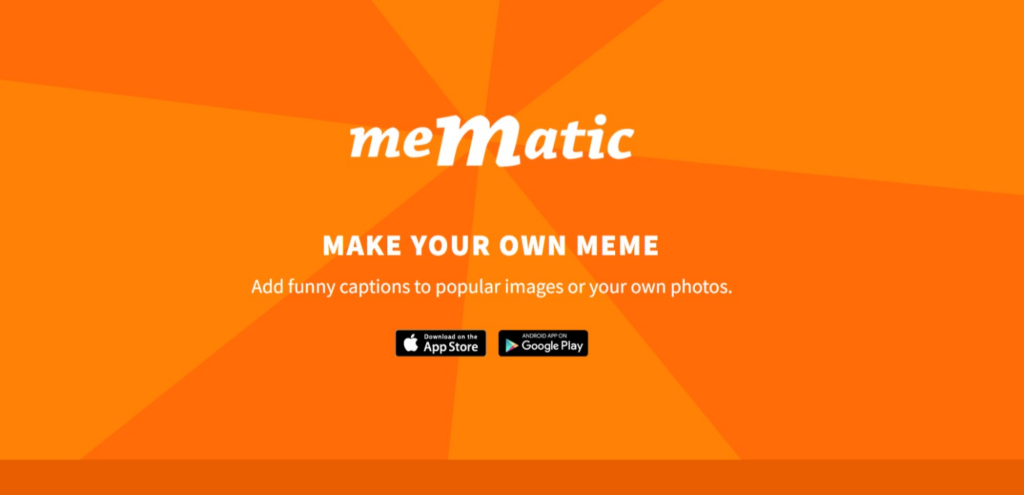
Mematic is one of the best tools available for creating memes. Users have two options: they can either create memes from scratch or use the pre-made templates in the tool’s collection.
This app offers marketers and business owners considerable latitude when creating memes from scratch. They can select a picture from their camera roll to use as the background for the meme.
After making all necessary changes, users can share their completed memes on various social media platforms.
Apart from being a meme-generating app, Mematic can also be used to create inspirational quotes.
Features
- Custom Meme Creation: Although Mematic has resources that users can make do with, it also allows them room for creativity. You can thus add texts and custom captions to your images and videos. You can also create your own collage and layout.
- Social Sharing: After users have created and designed their memes, they can share the results across social media platforms.
- Extensive Template Library: This tool has a wide range of designs in its library. Users can utilize the rich collection of illustrations, graphics, and funny photos.
Pros
- It allows for easy and quick creation of memes.
- It has an extensive collection of templates.
- The end product content is highly shareable.
- It is available on Android and iOS.
Cons
- Users can have a tough time choosing the best suitable option, because of the overwhelming amount of options.
- There are a lot of ads, especially when you save a meme.
Pricing
- Free
PiktoChart
Best for Infographics
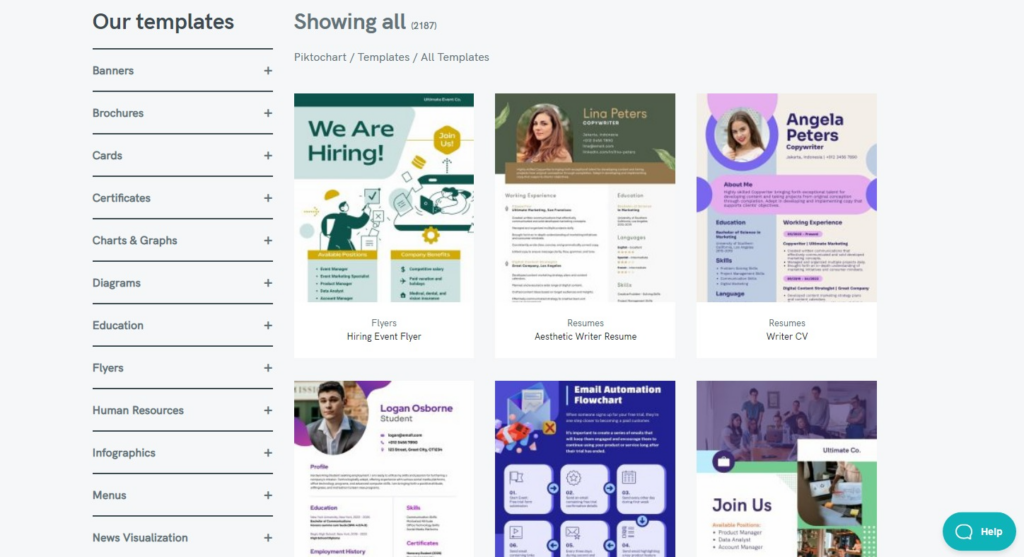
PiktoChart is renowned for creating informative visual content that blends texts and visuals, i.e., infographics, presentations, etc.
PiktoChart boasts over 100 themes and an expansive library of graphics. With these features, this tool saves brands time, effort, and money that would otherwise have been spent creating new designs from scratch.
With the design reservoir, you can easily create banners, reports, and more. They offer a variety of templates for reports, flyers, social media posts, and infographics. The best part? It’s a free infographic maker that includes a robust chart-making tool and other great features.
Features
- User-friendly Interface: PiktoChart is easy to use, even without elaborate training or previous professional experience in design. You can change the fonts, move images easily on the tool.
- Integration with ThirdParty Software: PiktoChart allows easy integration with its users’ workflow. You can download visual content in PPT, PDF, and PNG formats, which are also shareable.
- Video Editing: You can use Piktochart Video to edit video content without stress. This feature can be used to include transcriptions and subtitles in videos.
PiktoChart Video also allows users to crop video content to make it fit the social media platforms for which it is intended.
- Versatile Creation: PiktoChart can be used to beautify data in different forms of visual content. It helps to create infographics, videos, reports, presentations, schedules, posters, etc.
Pros
- Easy integration with Pexels library
- It has an extensive library of fonts, icons, and templates.
- The customer service is commendable.
Cons
- Social sharing on the free version can be tricky to use.
Pricing
- Free version. This plan is for novices, looking to launch or improve their visual communication skills.
- Pro – $14 per member, monthly. This plan is for experts and small teams looking to manage their brand marketing efficiently .
- Enterprise – Custom. This plan is for organizations with over 25 members.
Animaker
Best for Aminations
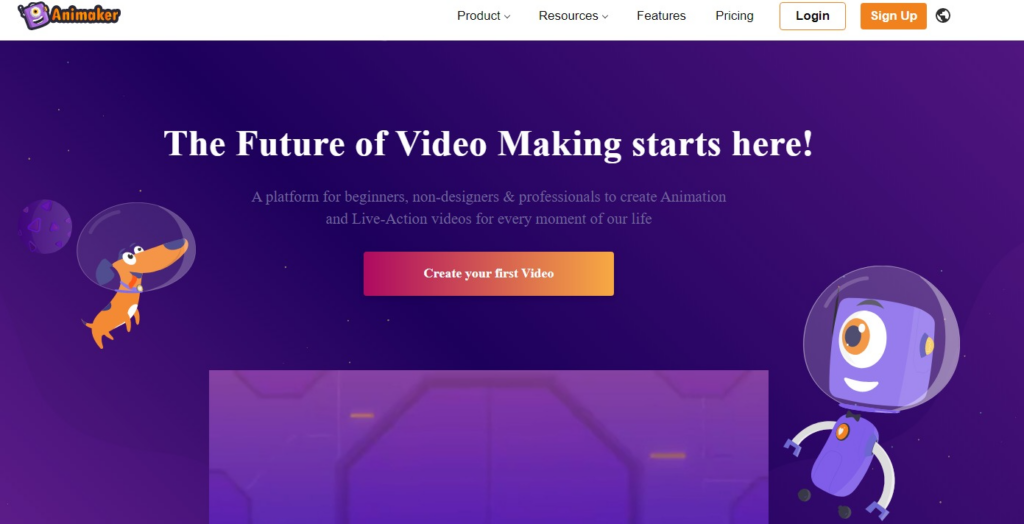
Animaker is an excellent tool for creating marketing animation and live-action videos. This software supports over 500 types of animated videos and boasts an extensive library of animated properties, icons, characters, backgrounds, and more.
You can use Animaker to create content other than animations, such as infographics, typography, whiteboards, and 2D and 2.5D graphics.
This tool supports custom fonts, RTL language fonts, and graphic design creation. Animaker is business-centric, and so it analyzes and promotes videos to increase a brand’s revenue.
In creating custom videos, Animaker uses over 12 facial features and at least 20 facial expressions to make marketing messages interesting. You can also watermark your content and add music and sound effects.
Features
- Multilingual: Animaker provides text support for multiple languages. As such, the animation video adjusts itself to the location it is to be displayed.
This is a good visual marketing method because it helps the brand reach more people. Therefore, a brand is not limited by geographical boundaries.
- Multi-user Collaboration: No businessperson can downplay the advantage of collaboration between brands. In recognizing this, Animaker allows team collaboration in animation and video creation.
- Auto Lip-Sync: Every detail matters, no matter how little. Animaker allows automated synchronization between voiceovers and characters’ lips.
This removes the stress of manually animating characters’ lips.
- Text Conversion. With this feature, Animaker uses its Neural TTEngine to convert texts into ultra-realistic voiceovers.
Pros
- It is easy to use as it does not require prior professional experience
- It is cloud-based, so you can edit from anywhere.
Cons
- Its online-only availability becomes a limitation when an internet connection is unavailable. .
Pricing
- Free version.
- Basic – $10 per month
- Starter – $19 per month
- Pro – $49 per month
- Enterprise – Custom Pricing
Vidgeos
Best for Video Marketing Content

When creating market-savvy video content, Vidgeos does a pretty good job. With its impressive features, it is suitable for Email Marketing, Lead Generation and Nurturing, Up-sell Video Marketing, Affiliate Marketing, etc.
Vidgeos helps produce quality and professional marketing videos tailored for each audience. Some features allow the display of the viewer’s location and time zone.
This tool also has stylish animations and other visual effects that cannot help but draw the interest of the audience. Another plus? Vidgeos integrates with Amazon S3
Vidgeos saves time by allowing businesspeople and marketers to live edit videos and do instant video publishing, as one would expect from a tool.
Features
- Email Opt-in Forms: This is a great marketing initiative that encourages potential consumers to subscribe to your newsletters, offers and promotions, and other forms of marketing emails.
This not only helps you generate leads as a brand, but it also helps nurture leads by building audience engagement and trust.
- Automated Translation: This is another helpful marketing strategy that automatically translates video content to the language of the target audience, as per the geographical location.
This feature helps a brand penetrate international markets.
- Interactive CTA Buttons: In marketing, a call to action button is a strategy used to solicit a response or an action from the target audience.
As a feature in Vidgeos, it helps a brand convert readers into leads by urging them (through interaction) to take certain steps in a marketing campaign.
- Live Countdown Timers: This feature helps to build anticipation in the minds of the audience, about a brand announcement. It is a form of virtual clock added to a webpage that counts down to when a brand would air or stream a particular video.
Marketers use this tool to draw attention to their businesses, thereby creating a sense of urgency and curiosity.
Pros
- Its live countdown timer feature helps to foster brand identity.
- It expands a brand’s outreach by making marketing videos accessible to an international audience through the auto-translation feature.
- The software is security-conscious.
Cons
- It is web-based, so it cannot be accessed without an internet connection.
Pricing
- $67 per month.
Google Charts
Best for Charts and Graphs
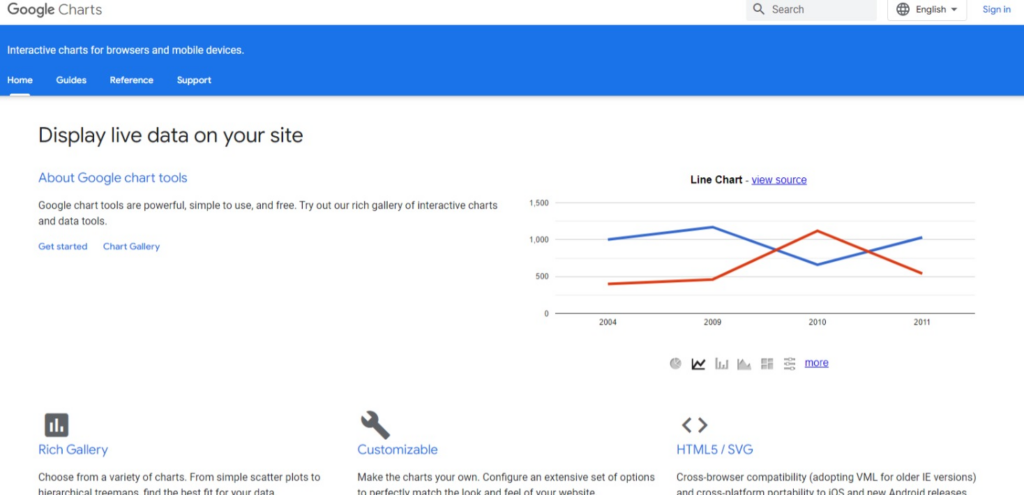
Google Charts is a cloud-based service that visualizes data in graphical forms based on user information. Google Charts is a big plus in a brand’s marketing arsenal because it brings information to them in an interactive manner such that data visualization is easy for customers.
Google Charts supports a wide range of marketing graphs and charts. You can choose the best way to show your data from the treemap, the histogram, the bubble chart, the pie chart, and the organizational chart.
Apart from its rich gallery of interactive designs, Google Charts also allows users to customize and configure the charts to meet the needs of their brands.
Features
- Customizable Dashboard. Although there are dashboards with ready-made display metrics in Google Charts, the tool also allows for flexibility by allowing users to alter the layout and content of dashboards. This would allow brands to customize the dashboard to fit their information or story.
- Extensive Visual Library. Google Charts is well suited for a wide variety of visual marketing campaigns since it allows for the display of information in different data sets. Whether a brand’s information is better displayed on a tree map, an organizational chart, a geo chart, a gauge , or a timeline, Google Chart can cater to the needs.
- Data Cleansing. When Google Charts detects that a particular data is irrelevant to the data set it belongs to, Google Charts automatically removes such data. Automatical removal also works for incomplete and inaccurate data.
- Display of Live Data. Displaying live data on your website as a brand makes it easy for customers to monitor certain metrics and indicators. This way, Google Charts helps customers visualize the data or information you’re passing across.
Pros
- It has an interactive dashboard that users can connect controls and charts to.
- It allows charts and graphs to be uploaded as social posts.
- It is available on the web, Android, and iOS.
- The software has a tutorial on how to use it.
- This tool can be used by small businesses and large enterprises.
Cons
- To fully partake of the benefits of Google Charts, you must have a foundational knowledge of data coding.
- It is not available for offline use.
Pricing
- Free.
FAQs
Visual language is a means of communicating through the use of visual elements. Visual language appeals to the sense of sight.
The kinds of visuals are:
. Interpretative
. Representational
. transformational
. mnemonic
. relational
. organizational
The following are the five C-qualities that must be present in an effective visual:
. Connection
. Clean
. Color
. Consistency
. Content
Three helpful hints for creating effective visuals are as follows:
. Use legible fonts where text is involved, e.g., infographics.
. Make it simple and easy to understand
. The graphics and illustrations should be of high quality.
A good visual marketing campaign must be:
. Relevant to the potential consumers’ pain points.
. Accurate where it states a fact.
. Easy for the audience to understand, no matter how complex the idea is.
. Delivered to the audience at the right time.
Conclusion
Brands that want to succeed in their marketing campaigns need to embrace the power of visuals. Unlike traditional marketing, visuals help brands connect with their customers in a more relatable way.
Brands can use images, memes, and animated gifs to create engaging campaigns that resonate with their target audience. If you want to make a lasting impression on your customers, it’s time to start using visuals in your marketing strategy.
